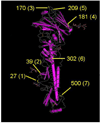Comparative glycomics analysis of influenza Hemagglutinin (H5N1) produced in vaccine relevant cell platforms
- PMID: 23848607
- PMCID: PMC3800089
- DOI: 10.1021/pr400329k
Comparative glycomics analysis of influenza Hemagglutinin (H5N1) produced in vaccine relevant cell platforms
Abstract
Hemagglutinin (HA) is the major antigen in influenza vaccines, and glycosylation is known to influence its antigenicity. Embryonated hen eggs are traditionally used for influenza vaccine production, but vaccines produced in mammalian and insect cells were recently licensed. This raises the concern that vaccines produced with different cell systems might not be equivalent due to differences in their glycosylation patterns. Thus, we developed an analytical method to monitor vaccine glycosylation through a combination of nanoLC/MS(E) and quantitative MALDI-TOF MS permethylation profiling. We then used this method to examine glycosylation of HAs from two different influenza H5N1 strains produced in five different platforms, including hen eggs, three different insect cell lines (High Five, expresSF+ and glycoengineered expresSF+), and a human cell line (HEK293). Our results demonstrated that (1) sequon utilization is not necessarily equivalent in different cell types, (2) there are quantitative and qualitative differences in the overall N-glycosylation patterns and structures produced by different cell types, (3) ∼20% of the N-glycans on the HAs produced by High Five cells are core α1,3-fucosylated structures, which may be allergenic in humans, and (4) our method can be used to monitor differences in glycosylation during the cellular glycoengineering stages of vaccine development.
Figures


 , GlcNAc;
, GlcNAc;  , Man;
, Man;  , Fuc. Oxonium ions at 204.09 and 528.19 are indicated.
, Fuc. Oxonium ions at 204.09 and 528.19 are indicated.
 , GlcNAc;
, GlcNAc;  , Man;
, Man;  , Fuc. Oxonium ions at 204.09 and 528.19 are indicated.
, Fuc. Oxonium ions at 204.09 and 528.19 are indicated.
 , GlcNAc;
, GlcNAc;  , Man;
, Man;  , Fuc;
, Fuc;  , GalNAc;
, GalNAc;  , Gal;
, Gal;  , NeuAc. Oxonium ions at 274.09 and 495.18 are indicated.
, NeuAc. Oxonium ions at 274.09 and 495.18 are indicated.
 , GlcNAc;
, GlcNAc;  , Man,
, Man,  Fuc. Peptide fragments with glycosyl neutral loss are indicated.
Fuc. Peptide fragments with glycosyl neutral loss are indicated.

References
-
- Influenza (Seasonal) WHO. http://www.who.int/mediacentre/factsheets/fs211/en/
-
- Ampofo WK, Baylor N, Cobey S, Cox NJ, Daves S, Edwards S, Ferguson N, Grohmann G, Hay A, Katz J, Kullabutr K, Lambert L, Levandowski R, Mishra AC, Monto A, Siqueira M, Tashiro M, Waddell AL, Wairagkar N, Wood J, Zambon M, Zhang W. Improving influenza vaccine virus selection: report of a WHO informal consultation held at WHO headquarters, Geneva, Switzerland, 14–16 June 2010. Influenza Other Respi Viruses. 2012;6(2):142–152. e1–e5. - PMC - PubMed
-
- Hess RD, Weber F, Watson K, Schmitt S. Regulatory, biosafety and safety challenges for novel cells as substrates for human vaccines. Vaccine. 2012;30(17):2715–2727. - PubMed
-
- Montomoli E, Khadang B, Piccirella S, Trombetta C, Mennitto E, Manini I, Stanzani V, Lapini G. Cell culture-derived influenza vaccines from Vero cells: a new horizon for vaccine production. Expert Rev Vaccines. 2012;11(5):587–594. - PubMed
Publication types
MeSH terms
Substances
Grants and funding
LinkOut - more resources
Full Text Sources
Other Literature Sources
Medical
Research Materials

